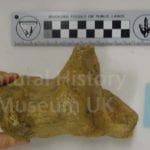 |
OLD-18 |
12470 |
|
|
CAL |
|
114 - Natural History Museum UK |
|
|
|
-- |
OLD-18 |
|
|
|
Unknown |
|
Mammalia |
Perissodactyla |
Ceratomorpha |
Tapiromorpha |
Rhinocerotoidea |
Rhinocerotidae |
|
|
|
|
|
|
No |
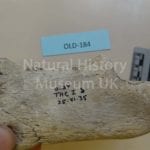 |
OLD-184 |
12475 |
9 - THC |
|
CAL |
|
114 - Natural History Museum UK |
I |
|
|
-- |
OLD-184; THC I S |
|
|
|
Unknown |
|
Mammalia |
Perissodactyla |
|
|
|
Equidae |
|
|
|
|
|
|
No |
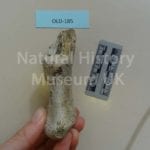 |
OLD-185 |
12476 |
|
|
CAL |
|
114 - Natural History Museum UK |
|
|
|
-- |
OLD-185 |
|
|
|
Unknown |
|
Mammalia |
Perissodactyla |
|
|
|
Equidae |
|
|
|
|
|
|
No |
|
OLD-186 |
12477 |
|
|
CAL |
|
114 - Natural History Museum UK |
|
|
|
-- |
OLD-186 |
|
|
|
Unknown |
|
Mammalia |
Perissodactyla |
|
|
|
Equidae |
|
|
|
|
|
|
No |
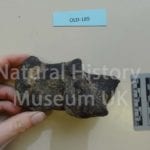 |
OLD-189 |
12480 |
35 - GTC |
|
CAL |
|
114 - Natural History Museum UK |
|
|
|
-- |
OLD-189; "OLD-Y GTC 14/5/35" |
|
|
|
Unknown |
|
Mammalia |
Perissodactyla |
|
|
|
Equidae |
|
|
|
|
|
|
No |
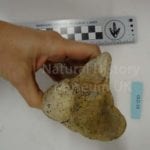 |
OLD-19 |
12482 |
|
|
CAL |
|
114 - Natural History Museum UK |
|
|
|
-- |
OLD-19 |
|
|
|
Unknown |
|
Mammalia |
Perissodactyla |
Ceratomorpha |
Tapiromorpha |
Rhinocerotoidea |
Rhinocerotidae |
|
|
|
|
|
|
No |
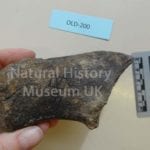 |
OLD-200 |
12488 |
|
|
CAL |
|
114 - Natural History Museum UK |
|
|
|
-- |
OLD-200; "IV S' 31" |
|
|
|
Unknown |
|
Mammalia |
Perissodactyla |
|
|
|
Equidae |
|
|
|
|
|
|
No |
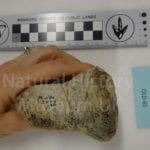 |
OLD-65 |
12777 |
|
|
OCC |
|
114 - Natural History Museum UK |
|
|
|
-- |
OLD-65; magnum |
|
|
|
Unknown |
|
Mammalia |
Perissodactyla |
Ceratomorpha |
Tapiromorpha |
Rhinocerotoidea |
Rhinocerotidae |
|
|
|
|
|
|
No |
|
OLD-73 |
12843 |
78 - FLK S |
|
CAL |
|
114 - Natural History Museum UK |
II |
|
|
-- |
OLD-73; "OLDY FLK II S ?.VII.35" |
|
|
|
Unknown |
|
Mammalia |
Perissodactyla |
Hippomorpha |
|
|
Equidae |
|
|
|
|
|
|
No |
|
M18783 |
3874 |
9 - THC |
|
CAR |
|
|
I |
|
|
-- |
All specimens for this paper are thought to be from one individual (MNI = 1). �Each specimen has its own specimen number. �This carpal is a lunate. |
|
|
|
Unknown |
|
Mammalia |
Perissodactyla |
Ceratomorpha |
Selenida |
Chalicotherioidea |
Chalicotheriidae |
Schizotheriinae |
Schizotheriini |
Ancylotherium |
hennigi |
|
|
No |
|
M18785 |
3875 |
9 - THC |
|
CAR |
|
|
I |
|
|
|
All specimens for this paper are thought to be from one individual (MNI = 1). �Each specimen has its own specimen number. �This carpal is a scaphoid. |
|
|
|
Unknown |
|
Mammalia |
Perissodactyla |
Ceratomorpha |
Selenida |
Chalicotherioidea |
Chalicotheriidae |
Schizotheriinae |
Schizotheriini |
Ancylotherium |
hennigi |
|
Shows resemblance to A. pentelicum. |
No |
|
M18784 |
3876 |
9 - THC |
|
CAR |
|
|
I |
|
|
Butler, P. M., 1965. Fossil Mammals of Africa No. 18. East African Miocene and Pleistocene Chalicotheres. Bulletin of the British Museum (Natural History) (Geology), 10: 163-23. |
All specimens for this paper are thought to be from one individual (MNI = 1). �Each specimen has its own specimen number. �This carpal is a cuneiform. |
|
|
|
Unknown |
|
Mammalia |
Perissodactyla |
Ceratomorpha |
Selenida |
Chalicotherioidea |
Chalicotheriidae |
Schizotheriinae |
Schizotheriini |
Ancylotherium |
hennigi |
|
|
No |
|
M18786 |
3877 |
9 - THC |
|
MTC |
|
|
I |
|
|
|
All specimens for this paper are thought to be from one individual (MNI = 1). �Each specimen has its own specimen number. �This is the second metacarpal. |
|
|
|
Unknown |
|
Mammalia |
Perissodactyla |
Ceratomorpha |
Selenida |
Chalicotherioidea |
Chalicotheriidae |
Schizotheriinae |
Schizotheriini |
Ancylotherium |
hennigi |
|
|
No |
|
M18782 |
3878 |
9 - THC |
|
MTC |
|
|
I |
|
|
|
All specimens for this paper are thought to be from one individual (MNI = 1). �Each specimen has its own specimen number. �This is the third metacarpal. |
|
|
|
Unknown |
|
Mammalia |
Perissodactyla |
Ceratomorpha |
Selenida |
Chalicotherioidea |
Chalicotheriidae |
Schizotheriinae |
Schizotheriini |
Ancylotherium |
hennigi |
|
|
No |
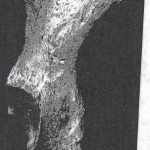 |
1116 |
3941 |
|
|
L-COX |
|
|
I/II |
|
|
Petter, G. 1973. Carnivores Pleistocenes du ravin d’Olduvai (Tanzanie). Fossil vertebrates of Africa 3:43-100. |
Author lists specimen in an assemblage that is described as coming from FLK N, FLK NN, KK, BK, and DK but does not specifically assign site. |
157 - L. Hlusko |
2012/6/28 |
|
Unknown |
|
Mammalia |
Perissodactyla |
Hippomorpha |
|
|
Equidae |
|
|
|
|
|
|
No |
|
1776 |
3946 |
|
|
R-C |
|
|
I/II |
|
|
Petter, G. 1973. Carnivores Pleistocenes du ravin d’Olduvai (Tanzanie). Fossil vertebrates of Africa 3:43-100. |
Author lists specimen in an assemblage that is described as coming from BK, THL, and FLK N but does not specifically assign site. |
157 - L. Hlusko |
2012/6/28 |
|
Unknown |
|
Mammalia |
Perissodactyla |
Hippomorpha |
|
|
Equidae |
|
|
|
|
|
|
No |
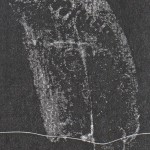 |
6158 |
3959 |
7 - FLK North |
|
C-f |
|
|
II |
|
|
Petter, G. 1973. Carnivores Pleistocenes du ravin d’Olduvai (Tanzanie). Fossil vertebrates of Africa 3:43-100. |
|
157 - L. Hlusko |
2012/6/28 |
|
Unknown |
|
Mammalia |
Perissodactyla |
Hippomorpha |
|
|
Equidae |
|
|
|
|
|
|
No |
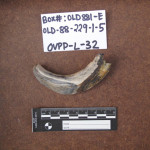 |
OVPP-L-32 |
3999 |
|
|
C |
|
126 - Mary Leakey Camp, Antiquities Station Olduvai Gorge, Tanzania |
|
|
|
-- |
Specimen label: OLD-88-229-1-5. Box #: OLD881-E. |
157 - L. Hlusko |
2012/6/29 |
|
Unknown |
|
Mammalia |
Perissodactyla |
Hippomorpha |
|
|
Equidae |
|
|
|
|
|
|
No |
|
M18783 |
7635 |
9 - THC |
|
CAR |
|
|
I |
|
|
-- |
All specimens for this paper are thought to be from one individual (MNI = 1). �Each specimen has its own specimen number. �This carpal is a lunate. |
|
|
|
Unknown |
|
Mammalia |
Perissodactyla |
Ceratomorpha |
Selenida |
Chalicotherioidea |
Chalicotheriidae |
Schizotheriinae |
Schizotheriini |
Ancylotherium |
hennigi |
|
|
No |
|
M18785 |
7636 |
9 - THC |
|
CAR |
|
|
I |
|
|
|
All specimens for this paper are thought to be from one individual (MNI = 1). �Each specimen has its own specimen number. �This carpal is a scaphoid. |
|
|
|
Unknown |
|
Mammalia |
Perissodactyla |
Ceratomorpha |
Selenida |
Chalicotherioidea |
Chalicotheriidae |
Schizotheriinae |
Schizotheriini |
Ancylotherium |
hennigi |
|
Shows resemblance to A. pentelicum. |
No |
|
M18784 |
7637 |
9 - THC |
|
CAR |
|
|
I |
|
|
|
All specimens for this paper are thought to be from one individual (MNI = 1). �Each specimen has its own specimen number. �This carpal is a cuneiform. |
|
|
|
Unknown |
|
Mammalia |
Perissodactyla |
Ceratomorpha |
Selenida |
Chalicotherioidea |
Chalicotheriidae |
Schizotheriinae |
Schizotheriini |
Ancylotherium |
hennigi |
|
|
No |
|
M18786 |
7638 |
9 - THC |
|
MTC |
|
|
I |
|
|
|
All specimens for this paper are thought to be from one individual (MNI = 1). �Each specimen has its own specimen number. �This is the second metacarpal. |
|
|
|
Unknown |
|
Mammalia |
Perissodactyla |
Ceratomorpha |
Selenida |
Chalicotherioidea |
Chalicotheriidae |
Schizotheriinae |
Schizotheriini |
Ancylotherium |
hennigi |
|
|
No |
|
M18782 |
7639 |
9 - THC |
|
MTC |
|
|
I |
|
|
|
All specimens for this paper are thought to be from one individual (MNI = 1). �Each specimen has its own specimen number. �This is the third metacarpal. |
|
|
|
Unknown |
|
Mammalia |
Perissodactyla |
Ceratomorpha |
Selenida |
Chalicotherioidea |
Chalicotheriidae |
Schizotheriinae |
Schizotheriini |
Ancylotherium |
hennigi |
|
|
No |
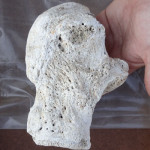 |
OVPP-322 |
8000 |
|
|
CAL |
|
126 - Mary Leakey Camp, Antiquities Station Olduvai Gorge, Tanzania |
I |
Lower |
1 meter above Bed I lavas. |
-- |
calcaneus |
157 - L. Hlusko |
2012/07/11 |
253 - OVPP |
No |
|
Mammalia |
Perissodactyla |
|
|
|
|
|
|
|
|
|
|
No |
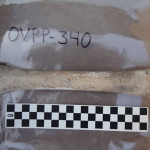 |
OVPP-340 |
8018 |
|
|
MTC |
|
126 - Mary Leakey Camp, Antiquities Station Olduvai Gorge, Tanzania |
II |
Lower |
1 meter below augitic sandstone. |
-- |
metacarpal |
157 - L. Hlusko |
2012/07/11 |
253 - OVPP |
No |
|
Mammalia |
Perissodactyla |
Hippomorpha |
|
|
Equidae |
|
|
|
|
|
|
No |
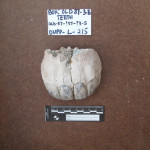 |
OVPP-L-215 |
8356 |
|
|
MAX, I, C |
|
126 - Mary Leakey Camp, Antiquities Station Olduvai Gorge, Tanzania |
|
|
|
-- |
Specimen label: OLD-87-?37-?3-S. Box #: OLD 87-3-E. Box label: Teeth. |
158 - W. Reiner |
2012/07/01 |
|
Unknown |
|
Mammalia |
Perissodactyla |
Hippomorpha |
|
|
Equidae |
|
|
|
|
|
|
No |
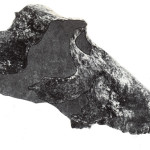 |
S. 196 |
3116 |
24 - DK |
|
CRA-f, P, M, C |
1969 |
104 - Unknown |
I |
|
|
Leakey, M., and Leakey, R. 1976. Further Cercopithecinae (Mammalia, Primates) from the Plio/Pleistocene of East Africa. Fossil vertebrates of Africa 4:121-146. |
This specimen is pictured in plate 1. |
142 - M. D. Leakey |
|
264 - Leakey family expedition |
Unknown |
|
Mammalia |
Primates |
Anthropoidea |
Haplorhini |
Cercopithecoidea |
Cercopithecidae |
Cercopithecinae |
Papionini |
Papio |
ap. |
|
|
No |
|
1011 |
3119 |
6 - FLK NN |
|
CRA-f, MAN-f |
1961 |
104 - Unknown |
I |
|
|
Leakey, M., and Leakey, R. 1976. Further Cercopithecinae (Mammalia, Primates) from the Plio/Pleistocene of East Africa. Fossil vertebrates of Africa 4:121-146. |
This specimen is crushed. |
142 - M. D. Leakey |
|
264 - Leakey family expedition |
Unknown |
|
Mammalia |
Primates |
Anthropoidea |
Haplorhini |
Cercopithecoidea |
Cercopithecidae |
Cercopithecinae |
Papionini |
Papio |
sp. |
|
|
No |
|
S. 61 |
3120 |
23 - TK |
|
CRA-f, MAN-f |
1961 |
104 - Unknown |
II |
|
|
Leakey, M., and Leakey, R. 1976. Further Cercopithecinae (Mammalia, Primates) from the Plio/Pleistocene of East Africa. Fossil vertebrates of Africa 4:121-146. |
This specimen is crushed. |
|
|
264 - Leakey family expedition |
Yes |
|
Mammalia |
Primates |
Anthropoidea |
Haplorhini |
Cercopithecoidea |
Cercopithecidae |
Cercopithecinae |
Papionini |
Papio |
sp. |
|
|
No |
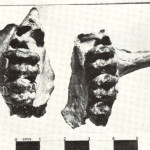 |
068/6514 |
3711 |
34 - MLK |
|
CRA, MAX-f, R/L-P, R/L-M |
|
104 - Unknown |
II |
middle |
|
Leakey, M. G., and Leakey, R. E. F. 1973. Pleistocene Colobinae from East Africa. Leakey, L. S. B., Savage, R. J. G., Coryndon, S. C., eds. In: Fossil Vertebrates of Africa,vol. 3. London: Academic Pr |
This specimen is pictured in plate 3. |
154 - Leakey and Leakey |
|
264 - Leakey family expedition |
Unknown |
|
Mammalia |
Primates |
Anthropoidea |
Haplorhini |
Cercopithecoidea |
Cercopithecidae |
Colobinae |
Colobini |
Cercopithecoides |
kimeui |
|
Holotype |
No |
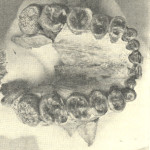 |
OH 5 |
3713 |
5 - FLK |
283 - 45 |
CRA
, MAX
, M
, I
, C
, P |
17 July - 6 August 1959 |
122 - National Museum and House of Culture, Dar es Salaam, Tanzania |
I |
Middle (Zinj.) |
22 feet below the upper limit of Bed I (Tuff IF), approximately 20 feet above basalt. |
Leakey, L. S. B. 1959. A new fossil skull from Olduvai. Nature 184:491-493. |
Holotype. Almost complete cranium. Adolescent. One reconstructed fossil found at House of Culture, Dar es Salaam, Tanzania. Specimen previously housed at National Museum of Kenya. Additional pieces from NMK unpublished. |
142 - M. D. Leakey |
|
264 - Leakey family expedition |
Yes |
|
Mammalia |
Primates |
Anthropoidea |
Haplorhini |
Hominoidea |
Hominidae |
|
|
Zinjanthropus |
boisei |
|
Holotype. This specimen was reclassified as Paranthropus boisei by Robinson (1960). |
No |
|
OH 2 |
3718 |
27 - MNK |
279 - 88 |
CRA-f |
1935 |
106 - Natural History Museum UK (?) |
III/IV |
Lowest horizon of Bed IVa. |
Surface. Found at head of MNK Gully where Beds II and IV are exposed. |
Leakey MD. (1971) Olduvai Gorge, Vol. 3: excavations in Beds I & II 1960-1963. New York, NY: Cambridge University Press. |
Two cranial vault fragments. Specimen previously housed at National Museum of Kenya. Not found at House of Culture, Dar es Salaam, Tanzania. |
142 - M. D. Leakey |
|
264 - Leakey family expedition |
No |
|
Mammalia |
Primates |
Anthropoidea |
Haplorhini |
Hominoidea |
Hominidae |
Homininae |
Hominini |
Homo |
erectus |
|
Similar to OH 9 and OH 12. |
No |
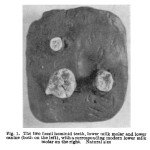 |
OH 3 |
3719 |
10 - BK |
280 - 94 |
d-C
, L-d-M |
1955 |
122 - National Museum and House of Culture, Dar es Salaam, Tanzania |
II |
Upper |
Upper part of BK channel which cuts into Tuff IID |
Leakey MD. (1971) Olduvai Gorge, Vol. 3: excavations in Beds I & II 1960-1963. New York, NY: Cambridge University Press. |
In the first publication of these specimens (Leakey, LSB, 1958), Leakey described the teeth as a deciduous lower canine and a left deciduous upper M2. "This view was not shared by Robinson, von Koenigswald and others, who preferred to regard it as either a permanent or a deciduous upper molar of an australopithecine character" (Leakey, MD, 1970:226). Specimen previously housed at National Museum of Kenya. |
130 - L.S.B. Leakey |
|
264 - Leakey family expedition |
Yes |
|
Mammalia |
Primates |
Anthropoidea |
Haplorhini |
Hominoidea |
Hominidae |
|
|
Australopithecus |
|
|
Referred to as species boisei in Tobias (Olduvai Gorge volume IV, 1991). |
No |
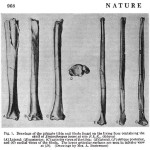 |
OH 6 |
3721 |
5 - FLK |
283 - 45 |
CRA-f
, M-f
, L-P
, L-TIB-f
, L-FIB-f
, |
1959/60 |
122 - National Museum and House of Culture, Dar es Salaam, Tanzania |
I |
Middle (Zinj.) |
Surface. Cranial and dental fragments found in surface soil from slope immediately below Zinj. site; assumed to be from Zinj. level (Leakey, MD, 1971:227). TIB-f and FIB-f from Zinj. level. |
Davis, P. R. 1964. Hominid fossils from Bed I, Olduvai Gorge, Tanganyika. A tibia and fibula. Nature. 201, 967. |
From Tobias (1991): OH 35 tibia and fibula attributed to same individual as OH 6 but appear to be more mature. It is unclear if OH 35 tibia and fibula are the same tibia and fibula originally listed under OH 6. Leakey, MD, 1971 describes CRA and dental fragments as having been found in surface soil, but Leakey, Tobias, and Napier, 1964 state "some [were] found in situ [and] some on the surface" (:9). Unworn lower L-P3. Partially developed roots of upper M1 or 2. Six cranial vault fragments. Tibia and fibula fragments first assumed to be associated with Zinjanthropus OH5, but should be considered associates with OH 6 following morphological study (Leakey, MD, 1971:227). and skull fragments. Juvenile. Specimen previously housed at National Museum of Kenya. |
|
|
264 - Leakey family expedition |
Unknown |
|
Mammalia |
Primates |
Anthropoidea |
Haplorhini |
Hominoidea |
Hominidae |
Homininae |
Hominini |
Homo |
habilis |
|
Paratype. TIB-f and FIB-f not given taxonomic designation in original publication (Davis, 1964) but named as a paratype in Leakey, Tobias, and Napier, 1964. |
No |
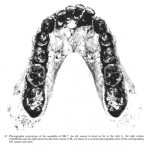 |
OH 7 |
3722 |
6 - FLK NN |
283 - 45 |
MAN
, L-PAR
, R-PAR-f
, M
, OCC-f
, L/R-TEM-f
, PHX
, CAR |
1960 |
122 - National Museum and House of Culture, Dar es Salaam, Tanzania |
I |
3 |
On surface of clay immediately overlying Tuff IB. |
Leakey, L.S.B., Tobias, P.V. & Napier, J.R. 1964. A new species of the genus Homo from Olduvai Gorge. Nature 202(4927): 7-9. |
Holotype. "Jonny's Child". Juvenile. Mandible with partial dentition and unerupted R/L-M3, almost complete left parietal and fragments of right parietal, left and right petrous portions (temporal) , "sundry small skull fragments ... [and] twenty-one bones of the hand, including the trapezium, scaphoid and a number of phalanges" (Leakey, MD, 1971:228). "One upper molar, a terminal phalanx, and a broken capitate bone, found on the surface, probably also belong to this individual" (:226). Specimen previously housed at National Museum of Kenya. |
|
|
264 - Leakey family expedition |
Yes |
|
Mammalia |
Primates |
Anthropoidea |
Haplorhini |
Hominoidea |
Hominidae |
Homininae |
Hominini |
Homo |
habilis |
|
Holotype |
No |
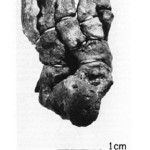 |
OH 8 |
3723 |
6 - FLK NN |
283 - 45 |
PHX
, CAR
, TAR
, CLA
, AST
, CAL
, CUNE
, CUB
, NAV
, M-f |
1960 |
122 - National Museum and House of Culture, Dar es Salaam, Tanzania |
I |
3 |
|
Leakey MD. (1971) Olduvai Gorge, Vol. 3: excavations in Beds I & II 1960-1963. New York, NY: Cambridge University Press. |
The molar-f was found on the surface and "probably also belongs to OH 8" (Leakey MD, 1971:228). Twelve associated foot bones including astragalus (has carnivore tooth marks (Leakey MD, 1971), calcaneus, cuboid and navicular, cuneiforms 1- 3, proximal ends with shafts, five metatarsals. Proximal ends of one metacarpal and three finger phalanges. One radius shaft. Clavicle with damaged articular ends. Foot articulates "almost perfectly with the OH 35 leg" (Susman, 1983:372). |
130 - L.S.B. Leakey |
|
264 - Leakey family expedition |
Yes |
|
Mammalia |
Primates |
Anthropoidea |
Haplorhini |
Hominoidea |
Hominidae |
Homininae |
Hominini |
Homo |
habilis |
|
Paratype |
No |
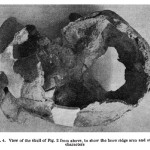 |
OH 9 |
3724 |
71 - LLK |
284 - 46 |
CALV |
2 December 1960 |
122 - National Museum and House of Culture, Dar es Salaam, Tanzania |
II |
Upper II D |
Surface |
Leakey LSB. 1966. Homo habilis, Homo erectus and the Australopithecines. Nature, 209(5030), 1279–1281. |
Calvaria. "Chellean Man." |
|
|
264 - Leakey family expedition |
No |
Yes. |
Mammalia |
Primates |
Anthropoidea |
Haplorhini |
Hominoidea |
Hominidae |
Homininae |
Hominini |
Homo |
erectus |
|
|
No |
|
OH 12 |
3727 |
18 - VEK |
286 - 86 |
OCC
, L/R-PAR
, L/R-TEM-f
, CRA-f
, L-PAL
, L-MAX
, TOOTH-f |
1962 |
122 - National Museum and House of Culture, Dar es Salaam, Tanzania |
IV? |
a |
Surface. Found on eroded slope of Bed III. L-TEM-f from just below marker Tuff IVa. |
Leakey, L., and Leakey, M. 1964. Recent discoveries of fossil hominids in tanganyika: at Olduvai and near Lake Natron. Nature 202:5-7. |
Crowns of teeth not preserved. Bed IVA determined on basis of matrix adhering to L-TEM-f and PAL. Specimen previously housed at National Museum of Kenya. |
|
|
264 - Leakey family expedition |
No |
L-TEM-f & PAL found with matrix adhering. |
Mammalia |
Primates |
Anthropoidea |
Haplorhini |
Hominoidea |
Hominidae |
Homininae |
Hominini |
Homo |
erectus |
|
|
No |
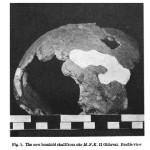 |
OH 13 |
3728 |
27 - MNK |
287 - 88 "Skull Site" |
MAN
, MAX
, CRA-f |
1963 |
122 - National Museum and House of Culture, Dar es Salaam, Tanzania |
II |
Lower Middle IIB |
5 feet above chert horizon |
|
Paratpye. "This consists of a sub-adult skull, probably female, with the third molars coming into wear. It is represented by the greater part of the mandible, including the complete dentition, although the crowns of the incisors are damaged and the left ascending ram us is not preserved; the greater part of the maxillae, represented by two fragments both lacking the anterior portions; the greater part of the occipital; the right parietal and temporal; parts of the left parietal and temporal; together with a few frontal fragments and approximately fifty additional pieces which it has not been possible to fit together" (Leakey MD, 1971:231). Specimen previously housed at National Museum of Kenya. 5 pieces found at House of Culture, Dar es Salaam, Tanzania. |
130 - L.S.B. Leakey |
|
264 - Leakey family expedition |
Yes |
|
Mammalia |
Primates |
Anthropoidea |
Haplorhini |
Hominoidea |
Hominidae |
Homininae |
Hominini |
Homo |
habilis |
|
Paratype |
No |
|
OH 14 |
3729 |
27 - MNK |
287 - 88 "Skull Site" |
CRA-f
, FRO-f
, R-PAR-f |
1963 |
122 - National Museum and House of Culture, Dar es Salaam, Tanzania |
II |
Lower Middle B |
Surface. Inferred as same horizon as OH 13 (Leakey MD, 1971). |
Leakey, L.S.B., Tobias, P.V. & Napier, J.R. 1964. A new species of the genus Homo from Olduvai Gorge. Nature 202(4927): 7-9. |
Juvenile (sutures unfused). Thin skull. Specimen previously housed at National Museum of Kenya. 11 pieces found at House of Culture, Dar es Salaam, Tanzania. |
130 - L.S.B. Leakey |
|
264 - Leakey family expedition |
No |
|
Mammalia |
Primates |
Anthropoidea |
Haplorhini |
Hominoidea |
Hominidae |
|
|
|
|
|
Juvenile, parietal is thin. |
No |





















